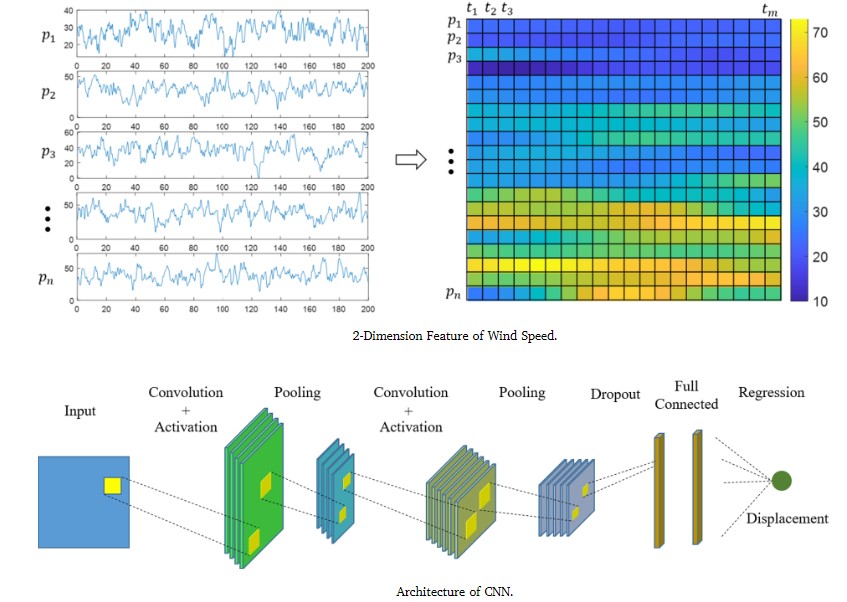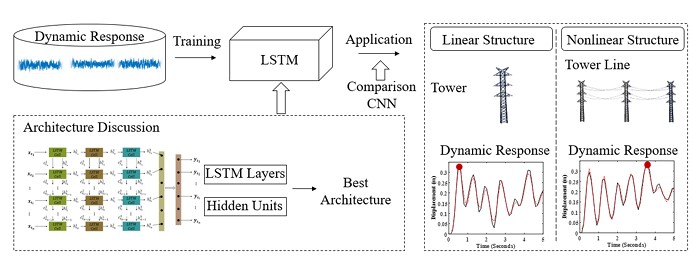Expedited Regional Hazard Impact Simulation
Aligning with the lab’s main theme, regional hazard impact mitigation and analysis, we believe that delivering a rapid and accurate regional infrastructural damage estimation given either a synthetic hazard scenario or a realistic hazard event is a prominent task for mitigation decision- and policy- making. The lab is interested in the utilization of domain knowledge in structural engineering modeling and testing with cross-disciplinary tools including statistics, data analytics, and machine learning to solve this unique interdisciplinary problem. Several ongoing thrusts under this subject include a rapid simulation of regional building damage in earthquake events and surrogate modeling of power transmission tower-line responses during complex wind dynamic loadings in a realistic hurricane wind field. The challenges of the expedited regional hazard impact simulation lay in the selection of the machine learning algorithm and the sparse sampling of the training data to cover the skewed and diverse high-dimension feature pool.
RELATED RESEARCH:
Transmission Tower System and Transmission Tower-Line System Dynamic Response Estimation using Machine Learning Method

We first proposed a machine learning approach based on a convolutional neural network (CNN) to predict the time history response of the transmission tower during the complex wind input. By preprocessing the time history of wind load and the tower’s dynamic response, a well-developed CNN can capture the time and spatial correlation of the wind load successfully and provide high accuracy results. CNN configuration, window size selection, and training data scale are carefully discussed to optimize the CNN design to maximize the prediction accuracy as well as minimize its computational time. By converting the time and spatial information of wind into a surface wave, CNN can predict the dynamic response of the transmission towers with satisfying accuracy.

Later we expand the surrogate model development to the transmission tower-line system, results indicate that CNN is not effective to train the surrogate model for the transmission tower-line system, a long short-term memory-based method is introduced and proved to work superior that the CNN method.
Read our work here: stand-alone transmission tower system, transmission tower-line system
Accelerated Large-scale Seismic Damage Simulation with a Bimodal Sampling Approach
Regional damage simulation is a promising method to prepare organizations for the unforeseeable impact of a probable seismic natural hazard. Nonlinear time history analysis (NLTHA) of the finite element models (FEM) of the buildings in a region can provide resembling results to the actual buildings’ damages and responses. This approach requires large-scale computational resources, and to improve efficiency, parallel processing and representing building FEM models with lumped mass models are proposed. However, the computing complexity is still far-reaching when high-performance computing is not available. The building inventory of a region consists of numerous similar buildings with a limited number of distinct structures. In this paper, we propose a data-driven method that runs the NLTHA for the distinct structures exclusively and infers the damage and responses of other buildings using a surrogate model. Considering the skewed distribution of the buildings in a region, a novel informative sample selection method is proposed that is designed for bimodal sampling of the input domain. We use the Gaussian process regression as the surrogate model and compare the performance of different sample selection methods. The proposed method is able to approximate the results of the regional damage simulation regarding total economic loss estimation with 98.99% accuracy while reducing the computational demand to about 1/7th of the simulation processing time.
Read the work here.